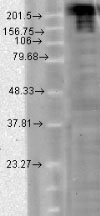Nav1.7 (SCN9A) Mouse Monoclonal Antibody [Clone ID: S68-6]
Other products for "SCN9A"
Specifications
| Product Data | |
| Clone Name | S68-6 |
| Applications | IHC, WB |
| Recommended Dilution | WB: 1-10ug/ml, IHC: 0.1-1.0ug/ml, IF: 1.0-10ug/ml |
| Reactivities | Human, Mouse, Rat |
| Host | Mouse |
| Isotype | IgG1 |
| Clonality | Monoclonal |
| Immunogen | Fusion protein amino acids 1751-1946 (C-terminus) of human Nav1.7 |
| Formulation | PBS pH7.4, 50% glycerol, 0.09% sodium azide |
| Concentration | lot specific |
| Purification | Protein G Purified |
| Conjugation | Unconjugated |
| Storage | Store at -20°C as received. |
| Stability | Stable for 12 months from date of receipt. |
| Gene Name | sodium voltage-gated channel alpha subunit 9 |
| Database Link | |
| Background | Ion channels are integral membrane proteins that help establish and control the small voltage gradient across the plasma membrane of living cells by allowing the flow of ions down their electrochemical gradient . They are present in the membranes that surround all biological cells because their main function is to regulate the flow of ions across this membrane. Whereas some ion channels permit the passage of ions based on charge, others conduct based on a ionic species, such as sodium or potassium. Furthermore, in some ion channels, the passage is governed by a gate which is controlled by chemical or electrical signals, temperature, or mechanical forces.There are a few main classifications of gated ion channels. There are voltage- gated ion channels, ligand- gated, other gating systems and finally those that are classified differently, having more exotic characteristics. The first are voltage- gated ion channels which open and close in response to membrane potential. These are then separated into sodium, calcium, potassium, proton, transient receptor, and cyclic nucleotide-gated channels; each of which is responsible for a unique role. Ligand-gated ion channels are also known as ionotropic receptors, and they open in response to specific ligand molecules binding to the extracellular domain of the receptor protein. The other gated classifications include activation and inactivation by second messengers, inward-rectifier potassium channels, calcium-activated potassium channels, two-pore-domain potassium channels, light-gated channels, mechano-sensitive ion channels and cyclic nucleotide-gated channels. Finally, the other classifications are based on less normal characteristics such as two-pore channels, and transient receptor potential channels .Nav1.7 is a voltage-gated sodium channel and plays a critical role in the generation and conduction of action potentials and is thus important for electrical signaling by most excitable cells. Therapeutically, the association of pain insensitivity with the loss of function of a certain sodium channel may have implications. Since Nav1.7 is not present in cardiac muscle or neurons in the central nervous system, blockers of Nav1.7 will not have direct action on these cells and thus can have less side effects than current pain medications. By performing more studies, there is a possibility to develop a new generation of drugs that can reduce the pain intensity in animals . |
| Synonyms | ETHA; FEB3B; GEFSP7; HSAN2D; Nav1.7; NE-NA; NENA; PN1; SFNP |
| Note | Detects ~230kDa. No cross-reactivity against other Nav channels. |
| Reference Data | |
| Protein Families | Druggable Genome, Ion Channels: Sodium |
Documents
| Product Manuals |
| FAQs |
{0} Product Review(s)
0 Product Review(s)
Submit review
Be the first one to submit a review
Product Citations
*Delivery time may vary from web posted schedule. Occasional delays may occur due to unforeseen
complexities in the preparation of your product. International customers may expect an additional 1-2 weeks
in shipping.






























































































































































































































































 Germany
Germany
 Japan
Japan
 United Kingdom
United Kingdom
 China
China




